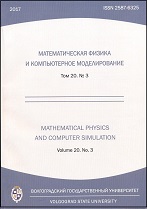|
This article is cited in 2 scientific papers (total in 2 papers)
Mathematics
The asymptotic of eigenvalues for difference operator with growing potentia
G. V. Garkavenkoa, N. B. Uskovab
a Voronezh State Pedagogical University
b Voronezh State Technical University
Abstract:
We consider $A: D(A)\subset l_2(\mathbb{Z})\to l_2(\mathbb{Z})$, $(Ax)(n)=a(n)x(n)$, $n\in\mathbb{Z}$, $x\in D(A)$,
and $(Bx)(n)=-2x(n)+x(n-1)+x(n+1)$. Let $a: \mathbb{Z}\to\mathbb{C}$ be a sequence with property:
1) $a(i)\ne a(j)$, $i\ne j$;
2) $\lim\limits_{|n|\to\infty}|a(n)|=\infty$;
3) $0<d_i=\inf_{i\ne j}|a(i)-a(j)|\to\infty$, $|i|\to\infty$.
By $\mathcal{A}$ we denote the operator $A-B$. By $P_n$ we denote $P_n=P(a(n), A)$, $n\in\mathbb{Z}$, and by $Q_k$ denote the operator
$Q_k=\sum\limits_{|i|\leqslant k}P_i$.
Theorem 1. There exists a number $k\geqslant 0$, such that the spectrum $\sigma(\mathcal{A})$ of operator $\mathcal{A}$ has form
$$
\sigma(\mathcal{A})=\sigma_{(k)}\bigcup\bigg(\bigcup_{|i|>k}\sigma_i\bigg),
$$
where $\sigma_{(k)}$ is a finite set with number of points not exceeding $2k+1$ and $\sigma_i=\{\mu_i\}$, $|i|>k$, are singleton sets.
The asymptotic formulas of eigenvalues have the following form:
$$
\mu_i=a(i)+2+O(d_i^{-1}),
$$
$$
\mu_i=a(i)+2-\frac{a(i+1)-2a(i)+a(i-1)}{(a(i+1)-a(i))(a(i-1)-a(i))}+O(d_i^{-3}), \quad |i|>k.
$$
Theorem 2.
Let the sequence $a:\mathbb{Z}\to\mathbb{C}$ satisfies the condition $\mathrm{Re}\,a(n)\leqslant\beta$
for all $n\in\mathbb{Z}$ and a $\beta\in\mathbb{R}$. Then the operator $\mathcal{A}$ is the generator of the semigroup
operators $T: \mathbb{R}_+\to\mathrm{End}\,l_2(\mathbb{Z})$ and this semigroup is similar to
$\widetilde{T}: \mathbb{R}_+\to\mathrm{End}\,l_2(\mathbb{Z})$ type
$$
\widetilde{T}(t)=\widetilde{T}_{(k)}(t)\oplus \widetilde{T}^{(k)}(t), \quad t\in\mathbb{R}_+,
$$
acting in $l_2(\mathbb{Z})=\mathcal{H}_{(k)}\oplus\mathcal{H}^{(k)}$, where $\mathcal{H}_{(k)}=\mathrm{Im}\,Q_k$ and
$\mathcal{H}^{(k)}=\mathrm{Im}\,(I-Q_k)$. The semigroup $\widetilde{T}^{(k)}: \mathbb{R}_+\to\mathrm{End}\,\mathcal{H}^{(k)}$
determined by the formula
$$
\widetilde{T}^{(k)}(t)x=\sum_{|n|>k}e^{\mu_nt}P_nx, \quad x\in\mathcal{H}^{(k)}, \quad t\in\mathbb{R}_+,
$$
where the numbers $\mu_n$, $|n|>k$, are defined by Theorem 1.
Theorem 3. Let $\alpha\leqslant \mathrm{Re}\,a(n)\leqslant\beta$, $\alpha$, $\beta\in\mathbb{R}$, for every $n\in\mathbb{Z}$.
Then the operator $\mathcal{A}: D(\mathcal{A})\subset l_2(\mathbb{Z})\to l_2(\mathbb{Z})$ is generator of group $T: \mathbb{R}\to
\mathrm{End}\,l_2(\mathbb{Z})$. This group is similar to $\widetilde{T}: \mathbb{R}\to \mathrm{End}\,l_2(\mathbb{Z})$, where
$\widetilde{T}(t)=\widetilde{T}_{(k)}(t)\oplus \widetilde{T}^{(k)}(t)$, $t\in\mathbb{R}$ and
$$
\widetilde{T}^{(k)}(t)x=\sum_{|n|>k}e^{\mu_nt}P_nx, \quad x\in\mathcal{H}^{(k)}, \quad t\in\mathbb{R}.
$$
Theorem 4.
Let the operator $\mathcal{A}: D(\mathcal{A})\subset l_2(\mathbb{Z})\to l_2(\mathbb{Z})$ be self-adjoint. Then $i\mathcal{A}$ is a generator of
isometric group $T: \mathbb{R}\to \mathrm{End}\,l_2(\mathbb{Z})$. This group is similar to
$$
\widetilde{T}(t)=\widetilde{T}_{(k)}(t)\oplus \widetilde{T}^{(k)}(t), \quad t\in\mathbb{R}.
$$
and
$$
\widetilde{T}^{(k)}(t)x=\sum_{|n|>k}e^{i\mu_nt}P_nx, \quad x\in\mathcal{H}^{(k)}, \quad t\in\mathbb{R}.
$$
Keywords:
method of similar operators, difference operator, eigenvalues, semigroup of operators, generator of operator semigroup.
Citation:
G. V. Garkavenko, N. B. Uskova, “The asymptotic of eigenvalues for difference operator with growing potentia”, Mathematical Physics and Computer Simulation, 20:4 (2017), 6–17
Linking options:
https://www.mathnet.ru/eng/vvgum192 https://www.mathnet.ru/eng/vvgum/v20/i4/p6
|

|




 Contact us:
Contact us: Terms of Use
Terms of Use
 Registration to the website
Registration to the website Logotypes
Logotypes








 Citation in format
Citation in format 
